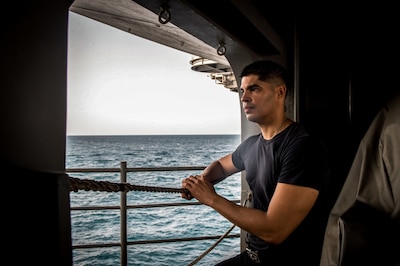CAMP H.M. SMITH, Hawaii, Oct. 30, 2017 — The chairman of the
Joint Chiefs of Staff hosted a trilateral conference with South Korean and
Japanese military leaders here yesterday.
Marine Corps Gen. Joe Dunford and his counterparts, South
Korean Air Force Gen. Jeong Kyeong-doo and Japanese Maritime Self-Defense Force
Adm. Katsutoshi Kawano, met at the U.S. Pacific Command headquarters.
The leaders focused on trilateral cooperation in Northeast
Asia to respond to increasingly provocative actions from North Korean leader
Kim Jong Un. The North Korean leader is persisting in developing nuclear
weapons and the missile systems to deliver them. He is continuing this effort
in the face of nearly universal condemnation and in defiance of a number of
United Nations Security Council resolutions.
This was the fifth trilateral meeting among the leaders
since July 2014. The military defense chiefs were joined by Navy Adm. Harry
Harris Jr., the Pacom commander; Army Gen. Vincent K. Brooks, the commander of
U.S. Forces Korea and the United Nations Command; and Air Force Lt. Gen. Jerry
P. Martinez, the commander of U.S. Forces Japan.
Violations of International Norms
The chiefs of defense exchanged views and information on the
North Korean violations of international norms. These include testing a nuclear
device on Sept. 3 and missile launches that overflew Japan's Hokkaido island in
July. The men "agreed to firmly respond to the acts in full coordination
with each other," according to a Joint Staff statement describing the
meeting.
In addition, the statement said, the three chiefs also
discussed multilateral and trilateral initiatives designed to improve
interoperability and readiness. Both Japan and South Korea have mutual defense
treaties with the United States, and each country has excellent military-to-military
relations with the U.S. military, officials added in the statement.
"They agreed to explore their collective capabilities
in humanitarian assistance and disaster relief, as well as leveraging their
unique competencies in the cyber domain" through the 2016 General Security
of Military Information Agreement, the statement said.
'Ironclad Commitment'
The three chiefs called on Kim to stop his provocative
behavior, and "walk away from its destructive and reckless path of
[weapons of mass destruction] development," the Joint Staff statement
said.
For his part, Dunford stressed America's
"ironclad" commitment to defend South Korea and Japan, and he
reaffirmed the extended deterrence guaranteed by the full spectrum of U.S.
military capabilities, including conventional, nuclear and missile defense assets.
The senior leaders vowed to continue to work together on
mutual security concerns to enhance peace and stability in the region, the
statement said.









